|
||||
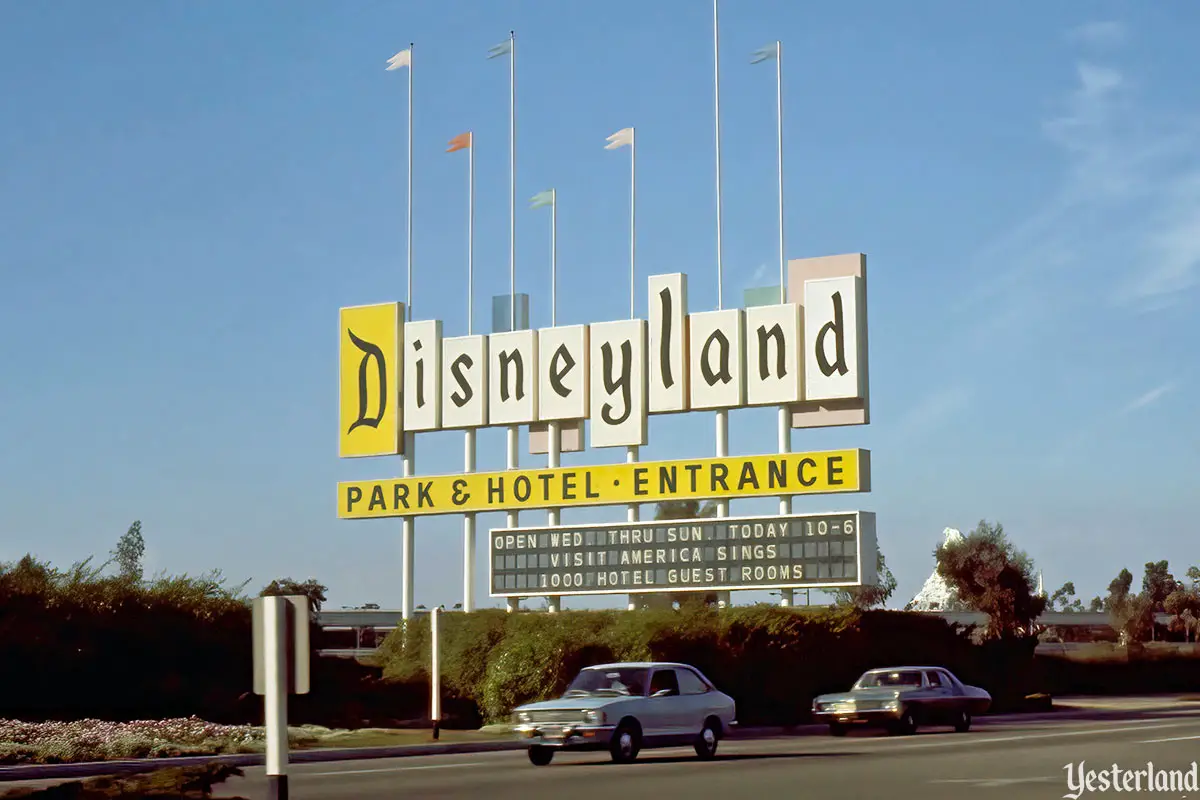
Photo by Werner Weiss, 1974 |
||||
|
“When you leave Yesterland, you might need a place to spend the night. Perhaps you’re hungry. Or you just want to get off your feet and watch a movie. Maybe your car could use a wash.” That was the premise of this Yesterland piece wth photos from 1974 when it was originally published in 1999 (with itty-bitty photos). This expanded version has additional photos, higher quality photos, and a lot more information.
|
||||
|
|
||||
|
Frontier Motel |
||||
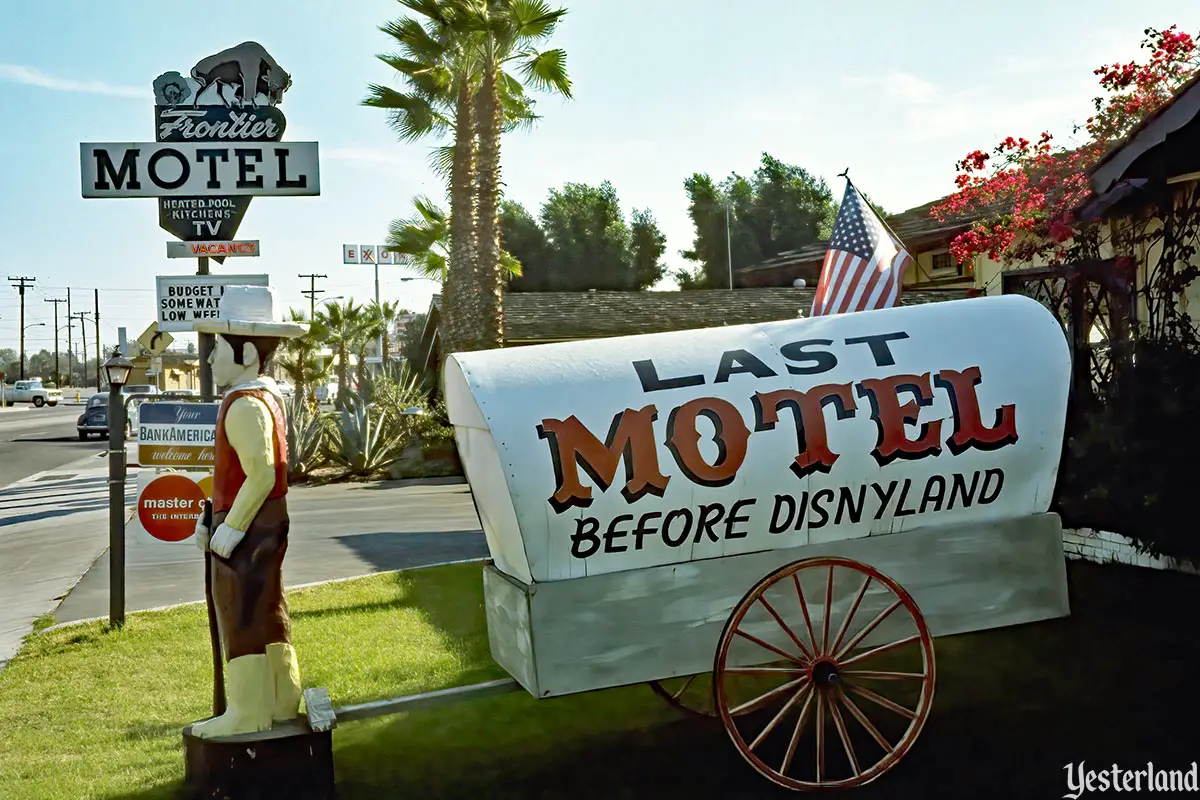
Photo by Werner Weiss, 1974 Frontier Motel, 933 South Harbor Boulevard, Anaheim, California |
||||
|
Yes, it’s the last motel before the park, as you head south on Harbor Boulevard. They don’t tell you that there are motels just beyond the park, and even across the street from it. Also, it appears that proper spelling wasn’t important in the old Frontier days. The Frontier Motel is almost as old as Disneyland. It’s still in business with the same name—including the word motel (which most lodging companies these days avoid), the same building, and its classic 1950s kidney-shaped swimming pool. The covered wagon with Disneyland spelled as Disnyland, the endearing folk-art cowboy, and the tall, freestanding sign are gone. The Frontier Motel now has a low-to-the-ground sign, in keeping with current Anaheim resort area sign standards. The current sign has a rodeo rider, a cactus, and a sunset on it, recalling the days when motels had individual identities, rather than the logos of global lodging chains. |
||||
|
Watergate Motel |
||||
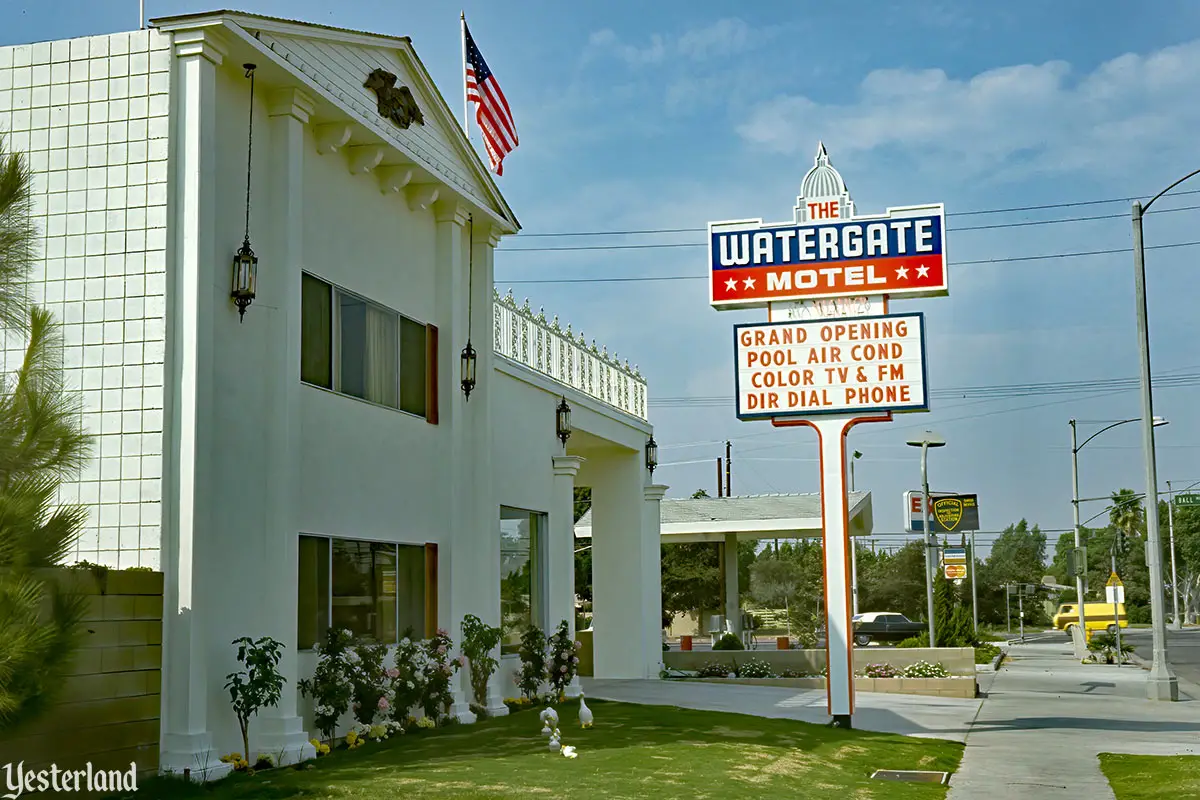
Photo by Werner Weiss, 1974 Watergate Motel, 1211 S. West Street, Anaheim, California |
||||
|
The break-in at the Democratic National Committee headquarters at the Watergate Hotel in Washington, D.C. on June 17, 1972 eventually led to the August 9, 1974 resignation of President Richard Nixon. With the Watergate scandal on the front pages of newspapers, the developers of a new motel in Anaheim decided to take advantage of the name recognition—despite the dubious value of being associated with criminal acts. As part of Disneyland area enhancements around the time of the 2001 opening of Disney’s California Adventure, S. West Street became Disneyland Drive and was rerouted away from the section where the motel stood. That section is now a very short road called West Place, connecting Ball Road to a Disneyland cast parking lot. The motel’s address became 1211 West Place. The Watergate Motel is now the Anaheim Maingate Inn—with a different paint scheme, green awnings, a low-to-the-ground sign, and a row of huge, beautiful evergreens hiding it from the street. It was previously the Anaheim Rodeway Inn Maingate. If you look closely, many of the old architectural features of the Watergate Motel are still there—but not the faux ducks or the lawn they were on. |
||||
|
Holiday Inn near Disneyland |
||||
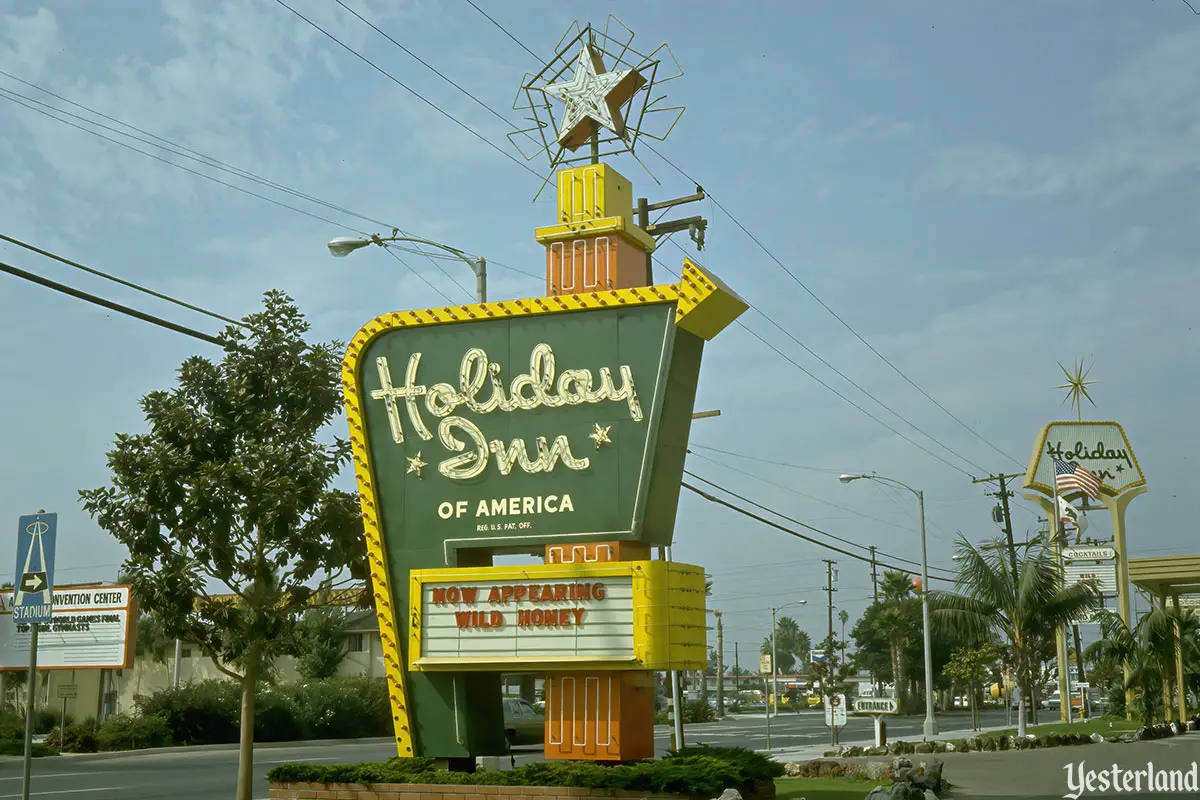
Photo by Werner Weiss, 1974 Holiday Inn, 1850 South Harbor Boulevard, Anaheim, California |
||||
|
They don’t make Holiday Inn signs like they used to. From the 1950s through the 1970s, the iconic Holiday Inn “Great Sign” greeted motorists across America. Long after other lodging chains had made the transition to simpler, more modern signs, the Holiday Inn chain continued to erect these large, expensive free-standing signs with neon and blinking lights. The Holiday Inn in Anaheim had a second, equally impressive, sign—unique to just this Holiday Inn. The rotating sign, with green script on a white background (in contrast to the usual white script on a green background), had a gold, multi-pointed star on top. The Holiday Inn’s lobby had originally been the Wide World in Wax, home to 200 wax sculptures of figures from the Bible, from history, and from legends. Opened by Walter Amusements, Inc. in 1965, the Wide World in Wax lasted only a few years. The developers of the Holiday Inn reused not only the building, but also the wax museum’s expensive sign. The former Holiday Inn Anaheim became the Red Lion Hotel Anaheim Resort. In 2021, it became Hotel Lulu, a BW Premier Collection by Best Western property. Its only freestanding sign is a relatively small, low-to-the-ground, “tasteful” sign along Harbor Boulevard. |
||||
|
Holiday Out |
||||
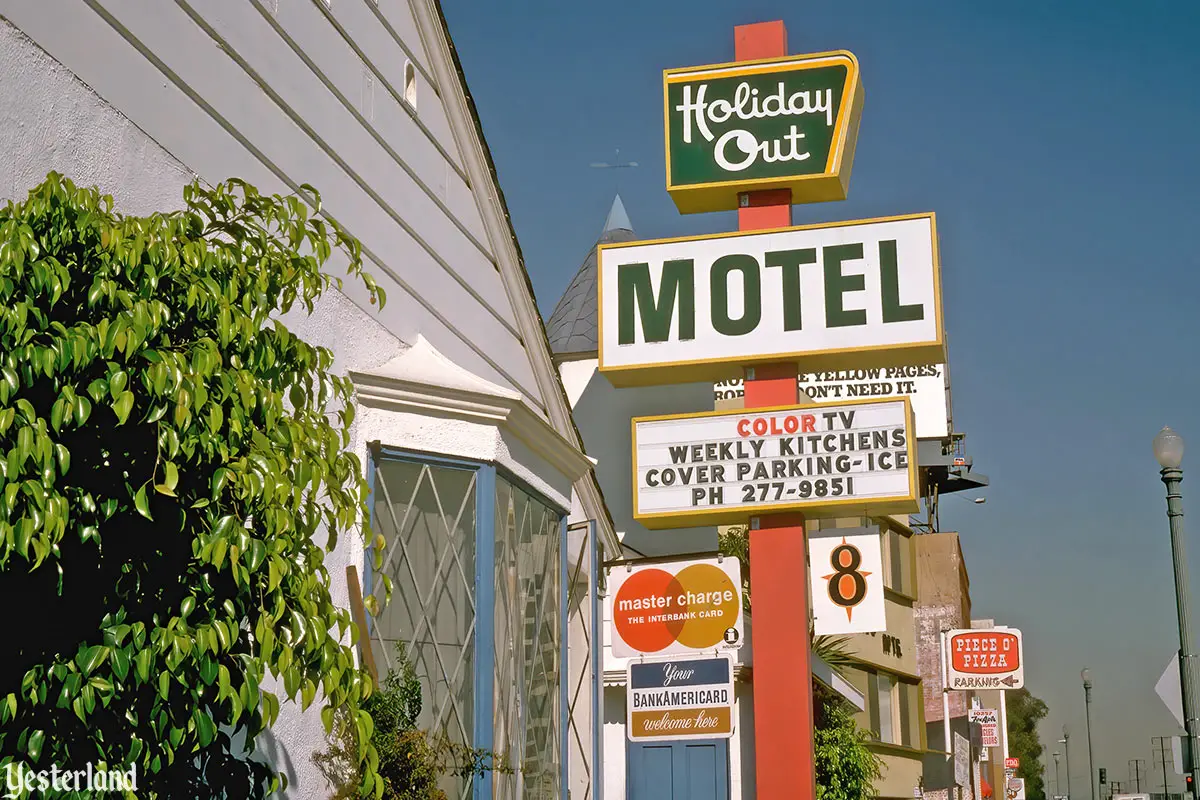
Photo by Werner Weiss, 1974 Holiday Out Motel, 10269 Santa Monica Boulevard, West Los Angeles, California |
||||
|
There have been thousands of Holiday Inns, but there was only one Holiday Out. Somebody was having fun when they came up with the name and sign for this motel across Santa Monica Boulevard from the shopping center that was then called Century Square Shopping Center and is now Westfield Century City. For hungry motel guests, Piece O’ Pizza was a very short walk away. There’s now a 19-unit luxury apartment building at the former location of Holiday Out Motel. The former Piece O’ Pizza is now Johnnie’s New York Pizzeria, using the same sign that’s in the 1974 photo, but with the current restaurant name. The small apartment building between them is still there. Holiday Out Motel took Master Charge and BankAmericard. If the credit card logos look familiar, it’s because “Master Charge: The Interbank Card” retained its distinctive interlocking circles design when its name changed to MasterCard in 1979; and BankAmericard retained its distinctive blue, white, and gold flag design when its name changed to Visa in 1977. |
||||
|
Alpha Beta - Hillview |
||||
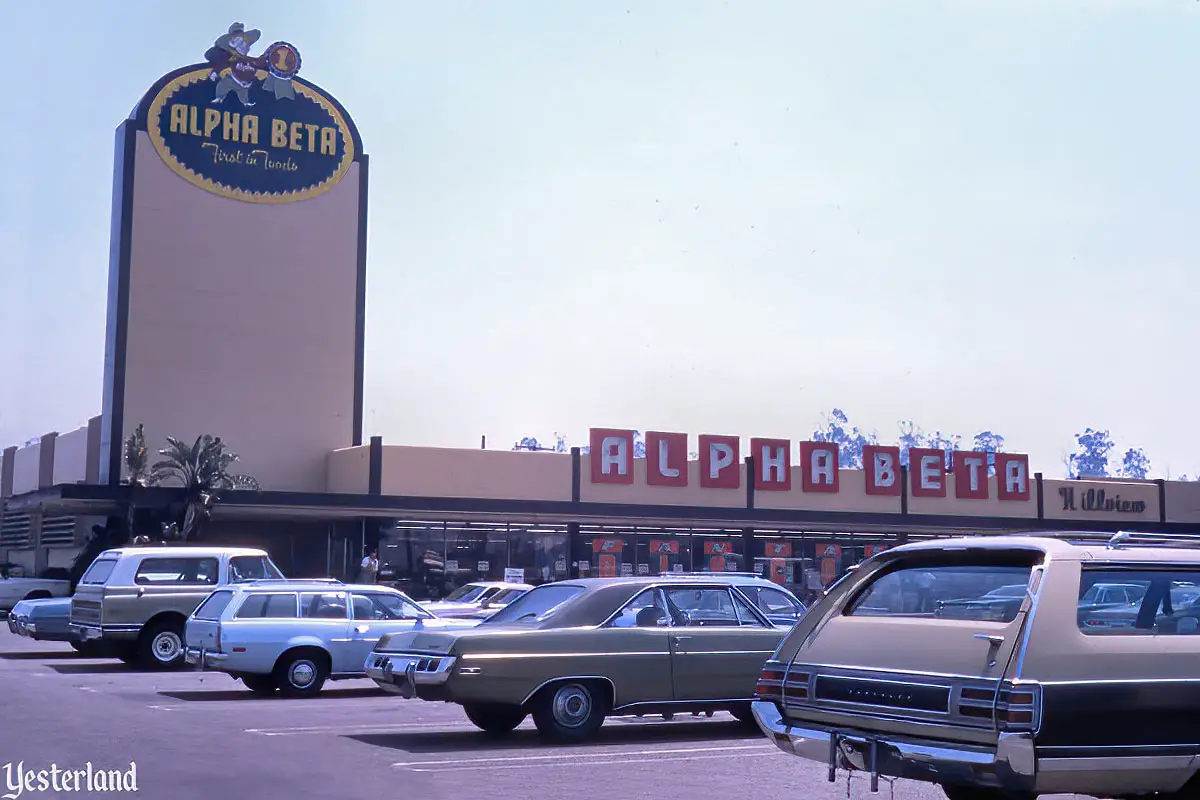
Photo by Werner Weiss, 1974 Alpha Beta store number 37, 2228 East 17th Street, Santa Ana, California |
||||
|
Piggly Wiggly claims it became America’s first true self-service grocery store in 1916, but, in 1915, Gerrard’s Triangle Groceteria in Pomona, California introduced its “Alpha Beta System” of self-service goods arranged alphabetically. Shelving anchovies next to ant poison might have seemed like a better idea than it was, but the Alpha Beta name took on a life of its own. The first Alpha Beta stores opened in 1917. Alpha Beta grew to become a chain with hundreds of stores, but the name disappeared in 1995 after a bewildering series of grocery industry mergers, divestitures, and rebrandings. The Alpha Beta store in the photo opened in 1958. By 1974, its architecture and sign tower looked quaint—which is why it was worthy of film and processing. In 1993, the entire abandoned shopping center was demolished after closing its doors to customers five years earlier. It was replaced by Centre on Seventeenth, a typical 1990s Orange County shopping center. |
||||
|
Drive In Car Service |
||||
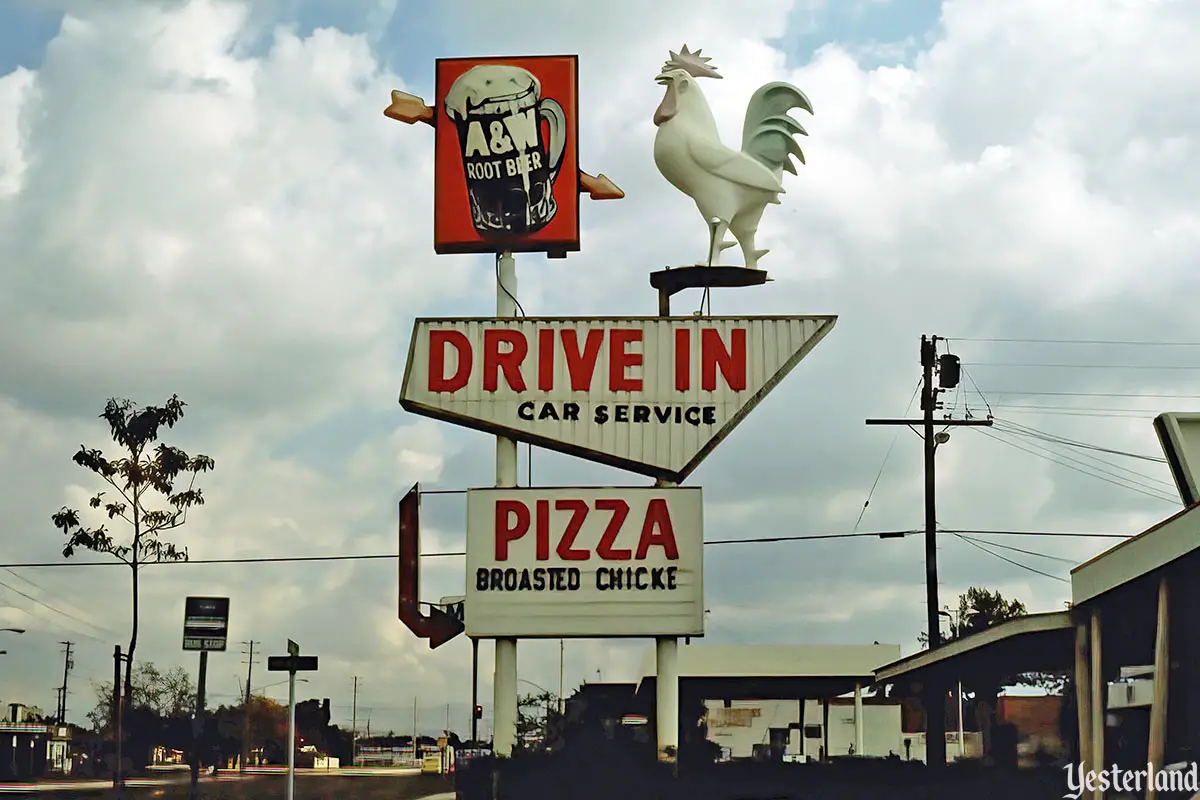
Photo by Werner Weiss, 1974 Drive In Car Service, 1904 W. First Street, Santa Ana, California |
||||
|
Where else can you get A&W Root Beer, pizza, and Broasted Chicken—all in the same place? What is Broasted Chicken (or “CHICKE” as the sign says), anyway? A quick Google search reveals that “trademarked Broasted chicken is still marinated in proprietary Chickite marinade, coated in Slo-Bro coating and pressure-fried in a Broaster pressure-fryer.” You could still have seen this sign as recently as 2020, with the same three shapes—and even the platform on which the rooster stood (but not the rooster himself). Instead of the old panels promoting root beer, car service, and pizza, new panels promoted Antojitos Don Chepe Authentic Mexican Food. The restaurant had closed several years earlier, but the building and sign lasted until they were demolished in 2020. |
||||
|
Chicken Boy |
||||
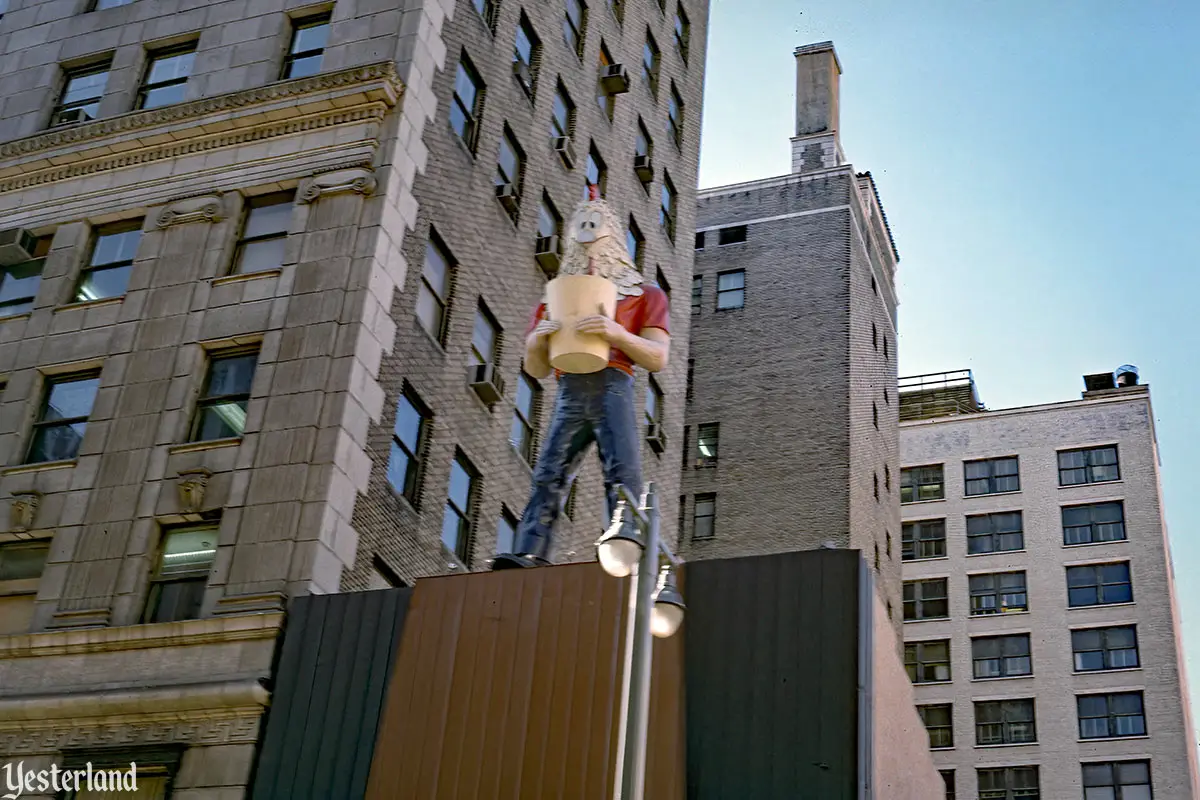
Photo by Werner Weiss, 1974 Chicken Boy, 450 S. Broadway, Los Angeles, California |
||||
|
Look! Up in the sky! It’s a chicken, It’s a boy. It’s Chicken Boy! With the body of a man and the head of a chicken, he stands over two stories tall. Could this be the result of a scientific experiment gone horribly wrong? On March 19, 2007, the Los Angeles Times had an article about Chicken Boy—even though the restaurant had been torn down in the 1980s. The article by columnist Al Martinez began like this: “Chicken Boy was lying in the sun behind a Highland Park studio when Amy Inouye reintroduced me to him after a separation of more years than I can remember. “He was in three parts: a stand, his human body and his chicken head, its round, dark eyes staring straight up into the afternoon glare. All 22 feet of his fiberglass body seemed in fine shape for someone who had been in a dissected condition for 23 years.” The article went on to explain that book designer Amy Inouye had obtained Chicken Boy when the restaurant was demolished. Inouye hoped that the City of Los Angeles would one day allow Chicken Boy to stand atop her Highland Park studio. Amy Inouye was successful. Chicken Boy has been on the roof of her studio since October 18, 2007. |
||||
|
Edwards Cinema |
||||
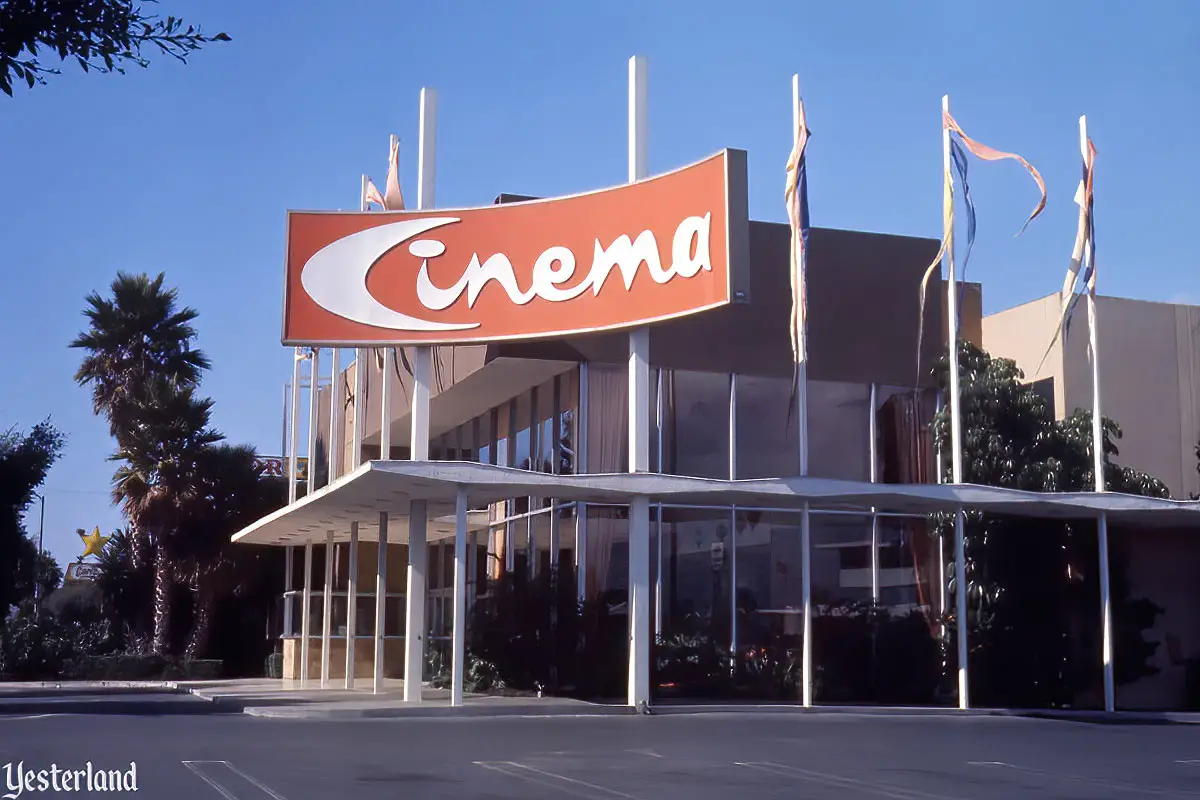
Photo by Werner Weiss, 1974 Edwards Cinema, 1534 Adams Street, Costa Mesa, California |
||||
|
What a movie theater! What an unabashedly oversized sign, yet with impeccable mid-century style! James Edwards II had been in the movie exhibition business since the 1930s, primarily in the San Gabriel Valley. By 1961, he had sold most of his theaters and was ready to live the good life as a retiree in Newport Beach. So what does a retiree do to keep busy? Edwards decided to open another movie theater. Movie exhibition was different then. Big movies would have exclusive engagements on a single screen in each big city, often for months, before finally going into wide release. Orange County residents had to drive to the movie palaces of Hollywood if they wanted to watch the lastest blockbusters—or they could wait. Edwards was convinced that Orange County could—and should—have its own theater for such movies. The new Edwards Cinema in Costa Mesa opened in 1963. It boasted 1,000 contoured seats, a gold theater curtain, matching gold draperies on the side walls, top-of-the-line projection and sound, and a huge 55x125-foot screen. In the following years, the industry changed. New movies would open nationwide on the same day on thousands of screens. Edwards would go on to dominate Orange County, primarily with multiplex theaters. By the end of the 1990s, new megaplexes doomed many smaller theaters—and their overbuilding caused a series of bankruptcies among theater chains. Huge, single-screen theaters had become obsolete. A few survived, but not Edwards Cinema in Costa Mesa. It closed permanently in 2000. Edwards Cinema became Paul Mitchell The School, offering cosmetology classes. After about a dozen years, the school moved out, the lobby portion of the building was demolished (providing parking in front of the building), and the auditorium became restaurant space. It’s currently Bonchon, part of an international Korean fried chicken chain. |
||||
|
Cinedome 20 and Cinedome 21 |
||||
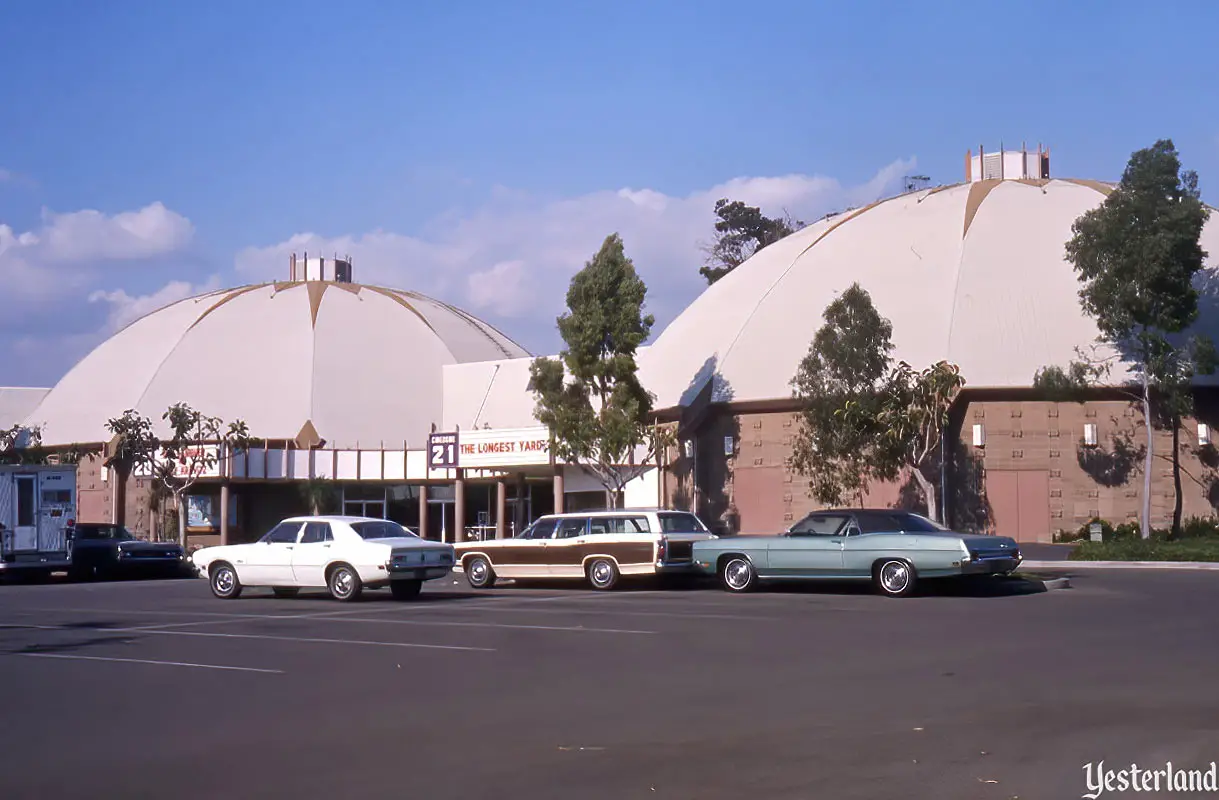
Photo by Werner Weiss, 1974 Cinedome 20 and Cinedome 21, 3001 W. Chapman Avenue, Orange, California |
||||
|
Based of the names of the theaters, you might expect Cinedome 1 through to 19 to be nearby. But, in 1974, there were just two theaters, which had opened in June 1969. The domes were huge, with 863 seats in each—only 74 fewer seats than Hollywood’s 937-seat Cinerama Dome, built in 1963. Each dome in Orange offered 70mm projection, 6-track stereophonic sound, and a giant curved screen with a curtain. The owner, Syufy Enterprises, had already opened similar theatres in Northern California. By the end of 1974, the original domes in Orange were joined by two additional, somewhat smaller domes. Expansions in 1977, 1986, and 1992 eventually brought the count to 11 screens in domed and conventional auditoriums, with a total of 5,600 seats. Syufy Enterprises became Century Theatres in the early 1990s. Although the final expansion of the Cinedome Theatres was in the 1990s, a new cinema trend in that decade doomed the domes—the movement toward megaplexes with dozens of stadium-seating auditoriums. The owner of the Cinedome Theatres, Century Theatres, opened Century Stadium Promenade 25 (now Century Stadium 25 & XD) in 1997 near Arrowhead Pond. A competitor, AMC, opened the AMC Orange 30 in 1998 at the Block of Orange. The Cinedome Theatres had become obsolete. They closed at the beginning of 1999 and were demolished the following year. There’s now a large apartment complex at their site. |
||||
|
Fox Cinemaland |
||||
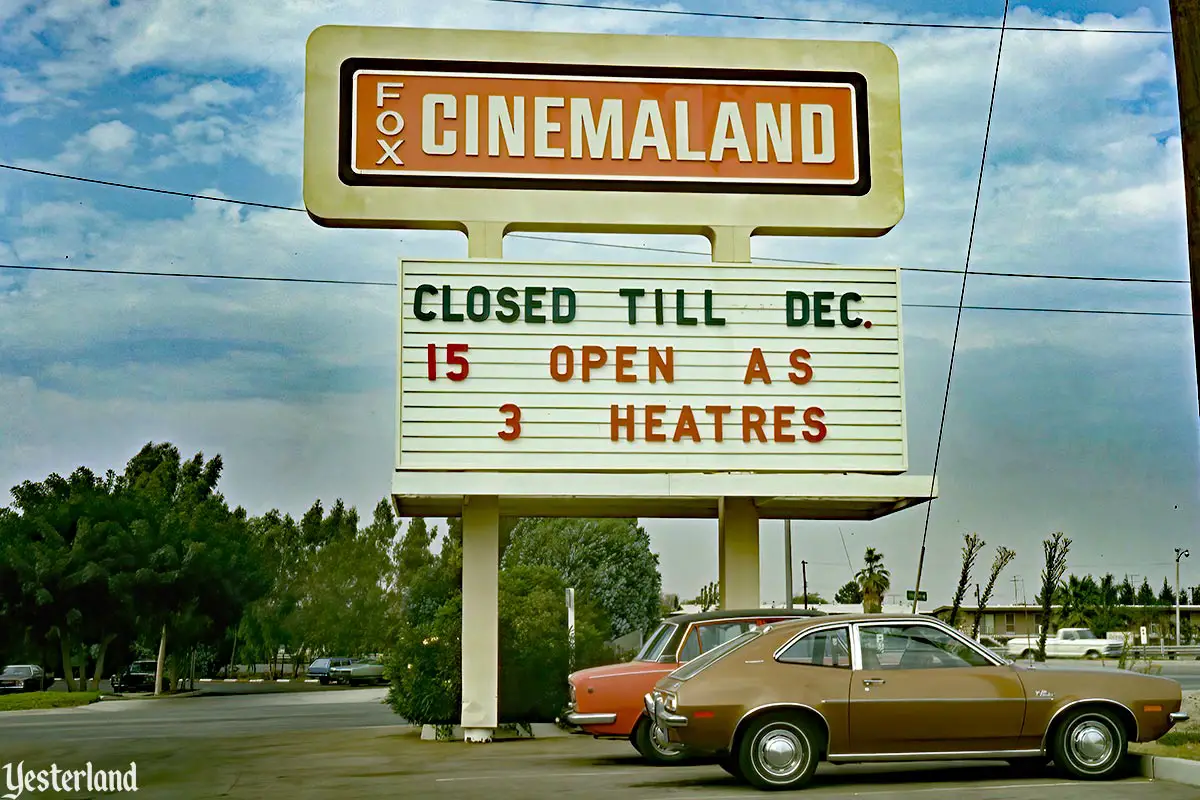
Photo by Werner Weiss, 1974 Fox Cinemaland, 1414 S. Harbor Boulevard, Anaheim, California |
||||
|
It can get pretty cold in December, even in Southern California, so maybe it’s a good thing that they’ll reopen as three heaters. Do you suppose that’s the British spelling of heater on the sign? On Chistmas day 1974, Fox Cinemaland reopened. The once well-proportioned auditorium had been butchered into three awkward, substandard auditoriums with relatively small screens. Fox Cinemaland had originally opened in 1968 as a deluxe, first-run movie theater with a huge screen and 70mm projection capability—a magnificent showplace for exclusive Orange County engagements in the days before big movies immediately went to wide releases. Its address was 1414 S. Harbor Blvd.—across the street from Tomorrowland at Disneyland, whose address was 1313 S. Harbor Blvd. For much of its final decade before its demolition in 1998, the theater sat vacant. You’ll now find Mimi’s Cafe on the parcel where Cinemaland and its parking lot had been. |
||||
|
South Coast Plaza Theatres |
||||
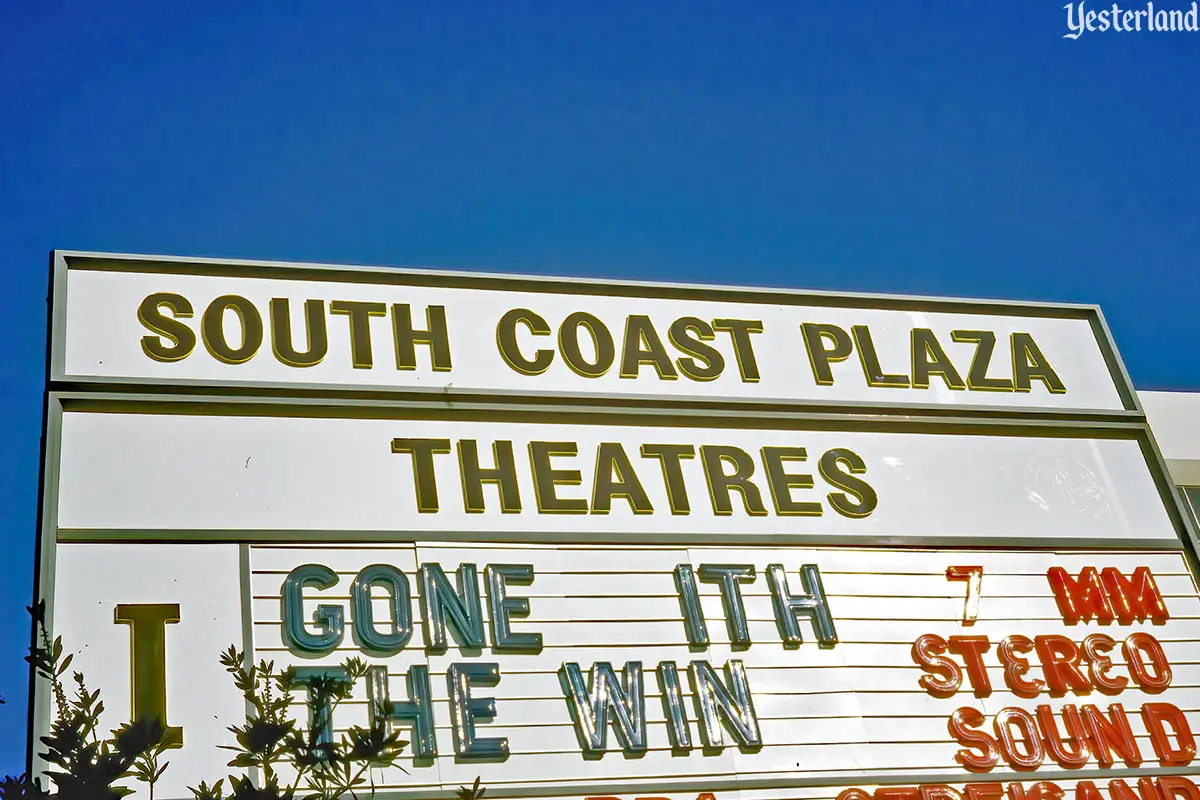
Photo by Werner Weiss, 1974 South Coast Plaza Theatres, South Coast Town Center, Costa Mesa, California |
||||
|
Is that the name of a movie on the marquee, or just an explanation of what happened to the missing letters? Wow! They’re showing the movie in 7 mm. That’s almost as good as 8 mm. The 1939 classic Gone with the Wind was re-released to movie theaters in 1974. Although the movie was made 35 years earlier, it had never been released to television. In an attempt to attract audiences of the 1970s who were accustomed to wide-screen movies, Gone with the Wind was blown up to 70 mm. The movie had originally been shot on 35 mm movie film with a 1.37:1 aspect ratio, a rectangular shape similar to a conventional television screen. To make 70 mm prints with a super-wide-screen 2.20:1 aspect ratio, the original composition of the movie was ruined. For example, in close-ups, the actors lost their foreheads and chins. That’s probably more than you wanted to know about the 1974 re-release of Gone with the Wind, but it explains why a 1939 movie was at a first-run theater in 1974. It also proves, once again, that people did a lot of stupid things in the 1970s. |
||||
|
God’s Car Wash |
||||
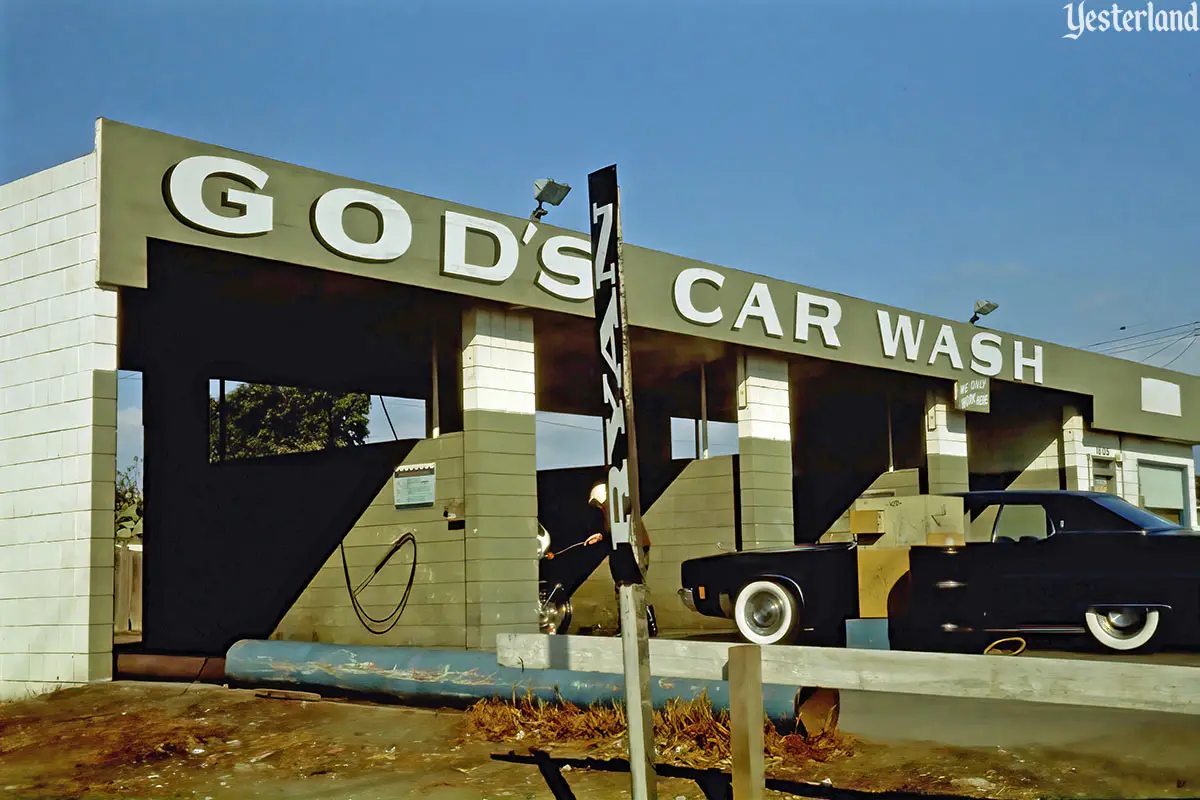
Photo by Werner Weiss, 1974 God’s Car Wash, 1805 W. First Street, Santa Ana, California |
||||
|
Perhaps you think that a heavy rainstorm is God’s car wash. If the name of this typical self-service car wash had been Bob’s Car Wash or Joe’s Car Wash, there would have been no reason to take a picture Why was it named God’s Car Wash? Was the owner’s given name God? Was it named out of reverence for the Almighty? Or was it simply an attempt at a memorable business name? Esteemed Orange Orange County historian Chris Jepsen has the answer: “Previously called the Two-Bit Car Wash, the name God’s Car Wash came to owner Art Grajczyk’s wife, Arlene, in a dream. She had a vision of the sign, and felt that their business—operating under God’s name—would be ‘the best place for us to witness and continue the Lord’s ministry.’ Religious messages were scattered about the property on posters. The Grajczyks were charismatic Christians, involved in Rev. Ralph Wilkerson’s Melodyland church and fans of Pat Robertson’s TV network. The car wash was set to go out of business in 1976 when their lease came up.” A look at Google Maps reveals that the structure is still there, but is no longer a car wash. |
||||
|
|
Click here to post comments at MiceChat about this article.
© 2023 Werner Weiss — Disclaimers, Copyright, and Trademarks Updated December 8, 2023 |
|||